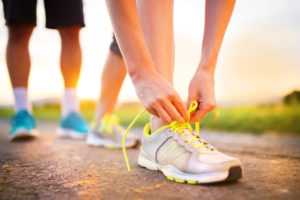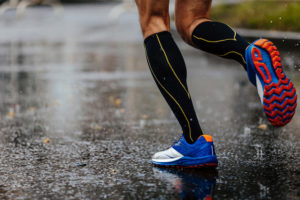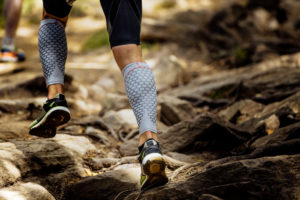Ultimate Guide: When to Replace Running Shoes
Not replacing your running shoes at the right time can be devastating. The number of injuries and setbacks can put your training back months.
So how do you know when to change those old sneakers?
In this guide, I’m going to go over several tests you can do to check if your shoes are worn, some of the common causes to shoe wear and tear, how to extend your shoes’ life, and finally some of the most common injuries to look out for caused by worn-out shoes.
Chapters
- The Myth of Mileage
- Shoe Tests
- Causes that Wear Out Shoes
- How to Extend the Life of Your Shoes
- Injuries Caused by Worn-Out Shoes
The Myth of Mileage

Most shoe stores, runners, and even a running coach will tell you that your shoes need to be replaced every 300-500 miles.
But did you ever wonder where that number came from?..
The concept of 300-500 miles came from a study done in 1985 titled Shock absorption characteristics of running shoes.
Although some excellent and solid conclusions have been drawn from that study, it does have some questionable flaws.
One problem with the study is that the research was never repeated to verify if its findings were accurate.
So to date, there has been no other studies done to back up the findings of the 1985 study.
Secondly, the study only focused on the energy absorption rate of shoes while many other factors could play into the wear and tear of a shoe, including uneven wear, holes, sturdiness, stretching, etc.
All in all, I don’t think the 300-500 mileage limit should be thrown out the window, as mileage certainly plays a part in overall wear. But there are a number of other additional factors that should also be checked.
Shoe Tests

Since mileage alone shouldn’t be your only yardstick as to when to replace your shoes, I’ve come up with 7 tests that can help you determine if it’s time to replace those kicks.
If your shoes fail one or more of these tests you should consider replacing them, it’s always better to be safe than sorry when it comes to shoes and injuries.
1) The Press Test
Press your thumb into the center sole of your shoe or where you strike most on the bottom of your shoe. If it feels mushy or soft, your shoe failed this test.
2) Look For Creases
Look over the shoe’s cushion on the sides and heal. If you find creases or cracks, the shoe failed this test.
3) Check For Wear Patterns
With your shoe placed on the floor observe it from behind. Do you see uneven wear? Now, look at the tread on the bottom of the shoe. Do you see any uneven wear? If you spot uneven wear then your shoes have failed the test.
4) Look Out For Aches & Pains
Are you starting to get aches and pains that don’t seem to be explained from your training riggers? Be on the lookout for knee, calf, foot, and shin pains as these can indicate worn shoes. If you do spot this, then your shoe failed this test.
5) Does it Feel Dead?
Are you noticing that your shoes sort of feel dead? Sort of like they just don’t have the life and energy they once had. Then it’s likely your shoes are worn out, and in such a case your shoes have failed this test.
6) Compare New Verse Old
Try running in a brand new pair of the same model shoes. Do you notice a different feel. Do they feel like you have more energy when you run in them? Do they feel more comfortable or more alive? Then it’s likely your shoes are worn, and they have failed this test.
7) Mileage
How much mileage do you have on your shoes? Recall from the 1985 study that it was found that running shoes tend to lose a significant amount of energy absorption after 300-500 miles. If your shoes are over 300-500 miles then they fail this test.
How to Track Shoe Mileage
Here are 2 of the best ways to easily track your shoe mileage.
- Online Running Log – Some online tracking and running logs allow you to track how many miles you’ve run on each pair of your shoes. One such running log is LogThatRun.com. Not only will it track your mileage but it will alert you when you’ve hit your max mileage for that shoe.
- Write the Date on Your Shoes – Inside the tongue of your shoes, write the date when you start running in them. Then periodically you can look back in your training log, watch, or tracking device and see how many miles you’ve run since the date on your shoes.
Causes that Wear Out Shoes

There are numerous things that contribute to shoes wearing out. Some or all of these factors may be at work or one of them may dominantly be the cause.
Here are the top 6 things that wear out your running shoes.
1) Runner’s Weight
Weight plays a factor in how much a shoe will wear. A heavier running will tend to wear out their shoes faster than a lighter runner. Therefore when selecting your shoes you may want to choose a shoe that has additional support if you’re a heavier runner.
2) Lack of Rotation
If you’re not rotating between pairs of shoes and using the same ones every day, then they’re going to wear much faster. It’s better to have at least 2 pairs of shoes to rotate between, thus decreasing wear.
3) Foot Strike
If you tend to either pronate or supinate, this uneven foot strike can cause more wear to one area of your shoes. Uneven wear will make your shoes wear out much faster.
4) Surfaces You Run On
Running shoes are made to be worn on specific surfaces. So repeatedly wear them on the wrong surface will cause more wear and tear. For example, if you’re doing a lot of runs on trails you’ll want to wear a trail running shoe verse a normal running shoe.
5) Poor Shoe Quality
This is probably obvious but shoes made of poor quality will be more likely to wear faster. This also extends to trying to run in shoes that are not made for running. Be on the lookout, because some brand and outlet stores sell or advertise shoes for running that are not actually running shoes.
6) Wet or Dirty Shoes
Shoes that are continuously wet will break down much faster over time. And dirt on shoes can act as an abrasive that also breaks down the shoe leading to more wear.
How to Extend the Life of Your Shoes

Here are the top 6 things you can do to get more life out of your shoes.
1) Rotate Two Pairs
Instead of only having one pair of running shoes, buy two. Rotate between the two pairs will put less repeated wear and tear on your shoes and make them last a little longer.
2) Dry Them Out
This is especially important in the summer months. By drying out your shoes you prevent bacteria from growing that can contribute to breaking down of the shoe material. Additional, wet shoes will degrade faster. So keeping them dry will extend a little more life out of them.
3) Clean Them Up
Dirt is an abrasive which can cause extra wear and tear on your shoes, so keeping your kicks clean can actually extend their life. Plus who doesn’t like clean shoes!
4) Tie Them Properly
Improperly tied shoes will cause extra rubbing and wear. So make sure you tie your shoes properly. Also, know that there are many ways to tie a running shoe for a better more comfortable fit. In fact, check out our running shoe lacing techniques graphic for a visual.
5) Run On Proper Surfaces
Believe it or not, running shoes are made to be worn on specific surfaces. The large majority of running shoes are to be worn on pavement. And then there are shoes made specifically for trail running. Using the shoe consistently with the wrong surface will lead to increase wear. So make sure you’re wearing the right shoe for the surface.
6) Don’t Run on Even Ground
If you make a habit of running the same routes weekly, make sure those the ground is as even as possible. Additionally, it’s a good idea to run the opposite direction or side of the walkway, road, train that you normally do. Most sidewalks and roads are slanted to drain off water. Running that same slant over and over again puts more wear on one side of your shoes.
Uneven wear breaks down your shoes faster.
So try to reduce or combat that by running opposite sides of the road or sidewalk. But of course never put your self in an unsafe situation. You should always face traffic when you run.
Injuries Caused by Worn-Out Shoes

1) Runner’s Knee
Shoes in poor condition can cause a number of knee problems. Runner’s Knee typically refers to any number of knee problems runners face.
2) Shin Splints
Shin splints can simply be described as a pain in your shins. Worn shoes can cause or exacerbate shin splits.
3) IT Band Syndrome
IT Band Syndrome is an injury where the IT band (group of ligaments on the outside of your knee) become irritated, tight, and possibly inflamed. Uneven shoe wear can contribute to and cause IT Band Syndrome.
4) Plantar Fasciitis
Plantar Fasciitis is the inflammation of the tissues on the bottom of your feet that connect the heel to the bones in your toes. Poor and worn shoes are a common cause of Plantar Fasciitis.
5) Stress Fracture
Stress fractures can be described as either bruising or a small crack in a bone. Worn shoes are typically part of, if not totally, the culprit to stress fractures in the foot and leg.
6) Hip Pain
Repeatedly running in shoes with uneven wear can quickly lead to hip injuries and pain. If your a pronator or supinator you could be more susceptible to this as your shoes wear.
7) Calf Pain
Calf pain can also, unfortunately, be linked to worn out shoes. What can happen is that the calf muscle becomes overworked due to the extra wear and tear and lack of support in your shoes.
0 Comments